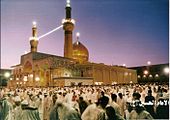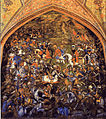
A | B | C | D | E | F | G | H | CH | I | J | K | L | M | N | O | P | Q | R | S | T | U | V | W | X | Y | Z | 0 | 1 | 2 | 3 | 4 | 5 | 6 | 7 | 8 | 9
| Part of a series on Shia Islam |
|---|
 |
|
|
| Part of a series on |
| Islam |
|---|
 |
Shia Islam (/ˈʃiːə/) is the second-largest branch of Islam. It holds that the Islamic prophet Muhammad designated Ali ibn Abi Talib (r. 656 – 661 CE) as his successor (khalīfa) and the Imam (spiritual and political leader) after him, at the event of Ghadir Khumm, but was prevented from succeeding Muhammad as leader of the Muslims by some of Muhammad's other companions (ṣaḥāba) at Saqifah. This view contrasts with Sunnī Islam, which asserts that Muhammad did not appoint a successor before his death and considers Abū Bakr, who was appointed caliph by a group of senior Muslims at Saqifah, to be the first rightful (rāshidūn) caliph after Muhammad (632–634 CE). Adherents of Shia Islam are called Shia Muslims.
Shia Islam is based on a hadith report concerning Muhammad's pronouncement at Ghadir Khumm. Shia Muslims believe that Ali, Muhammad's cousin and son-in-law, was the designated successor to Muhammad as Islam's spiritual and political leader. This belief later developed into the Imamah, the tradition that certain descendants of Muhammad, the Ahl al-Bayt, are rightful rulers or Imams through the bloodline of Ali and his firstborn son Ḥasan, whom Shia Muslims believe possess special spiritual and political authority over the Muslim community. Later events such as Husayn ibn Ali's martyrdom in the Battle of Karbala (680 CE) further influenced the development of Shia Islam, contributing to its formation as a distinct religious sect with its own rituals and shared collective memory.[1]
Shia Islam is the second-largest branch of Islam, followed by 10–15% of all Muslims. Although there are many Shia subsects in the Muslim world, Twelver Shīʿīsm is by far the largest and most influential, comprising about 85% of all Shia Muslims. Others include the Isma'ilis, Zaydis, and Alevis. Shia Muslims are a majority of the population in four countries across the Muslim world: Iran, Iraq, Azerbaijan, and Bahrain. Significant Shi’ite communities are also found in Lebanon, Kuwait, Turkey, Yemen, and the Indian subcontinent. Iran, a theocratic Islamic republic governed by a framework established by Ayatollah Khomeini known as the Guardianship of the Islamic Jurist, is the only country where Shia Islam is the foundation of both its laws and governance.[2]
Terminology
The word Shia derives from the Arabic term Shīʿat ʿAlī, meaning "partisans of Ali", "followers of Ali" or "faction of Ali".[3][4] Shīʿī (/ˈʃiːi/) denotes both the singular noun and the adjective form, while Shīʿiyyūn refers to the plural noun.[5] Shia or Shīʿa (/ˈʃiːə/), Shiism/Shīʿism (/ˈʃiːɪz(ə)m/), and Shiite/Shīʿite (/ˈʃiːaɪt/) are the forms used in English and other European languages for adherents, mosques, traditions, and things associated with the Shia branch of Islam.[6][7]
The term Shia was first used during Muhammad's lifetime.[8] At present, the word refers to the Muslims who believe that the leadership of the Muslim community after Muhammad belongs to Ali, Muhammad's cousin and son-in-law, and his successors.[9] Nawbakhti states that the term Shia refers to a group of Muslims who at the time of Muhammad and after him regarded Ali as the Imam and caliph.[9][10] Al-Shahrastani expresses that the term Shia refers to those who believe that Ali is designated as the heir, Imam, and caliph by Muhammad[9][11] and that Ali's authority is maintained through his descendants.[9][12] For the adherents of Shia Islam, this conviction is implicit in the Quran and the history of Islam. Shia Muslim scholars emphasize that the notion of authority is linked to the family of the Abrahamic prophets as the Quranic verses 3:33 and 3:34 show: "Indeed, Allah chose Adam, Noah, the family of Abraham, and the family of ’Imrân above all people. They are descendants of one another. And Allah is All-Hearing, All-Knowing."[13]
Beliefs
This section may require cleanup to meet Wikipedia's quality standards. The specific problem is: cluttered, inconsistent, and confusing. (October 2022) |
Shia Islam encompasses various denominations and subgroups,[3] all bound by the belief that the leader of the Muslim community (Ummah) should hail from Ahl al-Bayt, the family of the Islamic prophet Muhammad.[14] It embodies a completely independent system of religious interpretation and political authority in the Muslim world.[15][16]
Alī: Muhammad's Rightful Successor

Shia Muslims believe that just as a prophet is appointed by God alone, only God has the prerogative to appoint the successor to his prophet. They believe God chose Ali to be Muhammad's successor, infallible, the first caliph (khalīfa, head of state) of Islam. Shia Muslims believe that Muhammad designated Ali as his successor by God's command (Eid Al Ghadir).[17][18] Ali was Muhammad's first-cousin and closest living male relative as well as his son-in-law, having married Muhammad's daughter, Fāṭimah.[19][20]
Profession of faith (Shahada)

The Shia version of the Shahada, the Islamic profession of faith, differs from that of the Sunnīs.[21] The Sunnī version of the Shahada states "There is no god except God, Muhammad is the messenger of God", but to this declaration of faith Shia Muslims append the phrase Ali-un-Waliullah (علي ولي الله: "Ali is the Wali (custodian) of God"). The basis for the Shia belief in Ali as the Wali of God is derived from the Quranic verse 5:55.
This additional phrase to the declaration of faith embodies the Shia emphasis on the inheritance of authority through Muhammad's family and lineage. The three clauses of the Shia version of the Shahada thus address the fundamental Islamic beliefs of Tawḥīd (unity and oneness of God), Nubuwwah (the prophethood of Muhammad), and Imamah (the Imamate, leadership of the faith).[22]
Infallibility (Ismah)
Ismah is the concept of infallibility or "divinely bestowed freedom from error and sin" in Islam.[23] Muslims believe that Muhammad, along with other prophets and messengers in Islam, possessed ismah. Twelver and Isma'ili Shia Muslims also attribute the quality to Imams as well as to Fāṭimah, daughter of Muhammad, in contrast to the Zaydi Shias, who do not attribute ismah to the Imams.[24] Though initially beginning as a political movement, infallibility and sinlessness of the Imams later evolved as a distinct belief of (non-Zaydi) Shia Islam.[25]
According to Shia Muslim theologians, infallibility is considered a rational, necessary precondition for spiritual and religious guidance. They argue that since God has commanded absolute obedience from these figures, they must only order that which is right. The state of infallibility is based on the Shia interpretation of the verse of purification.[26][27] Thus, they are the most pure ones, the only immaculate ones preserved from, and immune to, all uncleanness.[28] It does not mean that supernatural powers prevent them from committing a sin, but due to the fact that they have absolute belief in God, they refrain from doing anything that is a sin.[23]
They also have a complete knowledge of God's will. They are in possession of all knowledge brought by the angels to the prophets (nabī) and the messengers (rāsūl). Their knowledge encompasses the totality of all times. Thus, they are believed to act without fault in religious matters.[29] Shia Muslims regard Ali as the successor of Muhammad not only ruling over the entire Muslim community in justice, but also interpreting the Islamic faith, practices, and its esoteric meaning. Ali is regarded as a "perfect man" (al-insan al-kamil) similar to Muhammad, according to the Shia viewpoint.[30]
Occultation (Ghaybah)

The Occultation is an eschatological belief held in various denominations of Shia Islam concerning a messianic figure, the hidden and last Imam known as "the Mahdi", that one day shall return on Earth and fill the world with justice. According to the doctrine of Twelver Shīʿīsm, the main goal of Imam Mahdi will be to establish an Islamic state and to apply Islamic laws that were revealed to Muhammad. The Quran does not contain verses on the Imamate, which is the basic doctrine of Shia Islam.[31] Some Shia subsects, such as the Zaydī Shias and Nizārī Ismāʿīlīs, do not believe in the idea of the Occultation. The groups which do believe in it differ as to which lineage of the Imamate is valid, and therefore which individual has gone into Occultation. They believe there are many signs that will indicate the time of his return.
Twelver Shia Muslims believe that the prophesied Mahdi and 12th Shīʿīte Imam, Hujjat Allah al-Mahdi, is already on Earth in Occultation, and will return at the end of time. Ṭayyibi Ismāʿīlīs and Fatimid/Bohra/Dawoodi Bohra believe the same but for their 21st Ṭayyib, At-Tayyib Abi l-Qasim, and also believe that a Da'i al-Mutlaq ("Unrestricted Missionary") maintains contact with him. Sunnī Muslims believe that the future Mahdi has not yet arrived on Earth.[32]
Hadith tradition
Shia Muslims believe that the status of Ali is supported by numerous hadith reports, including the Hadith of the pond of Khumm, Hadith of the two weighty things, Hadith of the pen and paper, Hadith of the invitation of the close families, and Hadith of the Twelve Successors. In particular, the Hadith of the Cloak is often quoted to illustrate Muhammad's feeling towards Ali and his family by both Sunnī and Shia scholars. Shia Muslims prefer to study and read the hadith attributed to the Ahl al-Bayt and close associates, and most have their own separate hadith canon.[33][34]
Holy Relics (Tabarruk)
Shia Muslims believe that the armaments and sacred items of all of the Abrahamic prophets, including Muhammad, were handed down in succession to the Imams of the Ahl al-Bayt. Jaʿfar al-Ṣādiq, the 6th Shīʿīte Imam, in Kitab al-Kafi mentions that "with me are the arms of the Messenger of Allah. It is not disputable."[35]
Further, he claims that with him is the sword of the Messenger of God, his coat of arms, his Lamam (pennon) and his helmet. In addition, he mentions that with him is the flag of the Messenger of God, the victorious. With him is the Staff of Moses, the ring of Solomon, son of David, and the tray on which Moses used to offer his offerings. With him is the name that whenever the Messenger of God would place it between the Muslims and pagans no arrow from the pagans would reach the Muslims. With him is the similar object that angels brought.[35]
Al-Ṣādiq also narrated that the passing down of armaments is synonymous to receiving the Imamat (leadership), similar to how the Ark of Covenant in the house of the Israelites signaled prophethood.[35] Imam Ali al-Ridha narrates that wherever the armaments among us would go, knowledge would also follow and the armaments would never depart from those with knowledge (Imamat).[35]
Other doctrines
Doctrine about necessity of acquiring knowledge
According to Muhammad Rida al-Muzaffar, God gives humans the faculty of reason and argument. Also, God orders humans to spend time thinking carefully on creation while he refers to all creations as his signs of power and glory. These signs encompass all of the universe. Furthermore, there is a similarity between humans as the little world and the universe as the large world. God does not accept the faith of those who follow him without thinking and only with imitation, but also God blames them for such actions. In other words, humans have to think about the universe with reason and intellect, a faculty bestowed on us by God. Since there is more insistence on the faculty of intellect among Shia Muslims, even evaluating the claims of someone who claims prophecy is on the basis of intellect.[36][37]
Practices

Shia religious practices, such as prayers, differ only slightly from the Sunnīs. While all Muslims pray five times daily, Shia Muslims have the option of combining Dhuhr with Asr and Maghrib with Isha', as there are three distinct times mentioned in the Quran. The Sunnīs tend to combine only under certain circumstances.
Holidays
Shia Muslims celebrate the following annual holidays:
- Eid ul-Fitr, which marks the end of fasting during the month of Ramadan
- Eid al-Adha, which marks the end of the Hajj or pilgrimage to Mecca
- Eid al-Ghadeer, which is the anniversary of the Ghadir Khum, the occasion when Muhammad announced Ali's Imamate before a multitude of Muslims.[38] Eid al-Ghadeer is held on the 18th of Dhu al-Hijjah.
- The Mourning of Muharram and the Day of Ashura for Shia Muslims commemorate the martyrdom of Husayn ibn Ali, brother of Hasan and grandson of Muhammad, who was killed by Yazid ibn Muawiyah in Karbala (central Iraq). Ashura is a day of deep mourning which occurs on the 10th of Muharram.
- Arba'een commemorates the suffering of the women and children of Ḥusayn ibn Ali's household. After Ḥusayn was killed, they were marched over the desert, from Karbala (central Iraq) to Shaam (Damascus, Syria). Many children (some of whom were direct descendants of Muhammad) died of thirst and exposure along the route. Arbaein occurs on the 20th of Safar, 40 days after Ashura.
- Mawlid, Muhammad's birth date. Unlike Sunnī Muslims, who celebrate the 12th of Rabi' al-awwal as Muhammad's day of birth or death (because they assert that his birth and death both occur in this week), Shia Muslims celebrate Muhammad's birthday on the 17th of the month, which coincides with the birth date of Jaʿfar al-Ṣādiq, the 6th Shīʿīte Imam.[39]
- Fāṭimah's birthday on 20th of Jumada al-Thani. This day is also considered as the "'women and mothers' day"[40]
- Ali's birthday on 13th of Rajab.
- Mid-Sha'ban is the birth date of the 12th and final Twelver imam, Muhammad al-Mahdi. It is celebrated by Shia Muslims on the 15th of Sha'aban.
- Laylat al-Qadr, anniversary of the night of the revelation of the Quran.
- Eid al-Mubahila celebrates a meeting between the Ahl al-Bayt (household of Muhammad) and a Christian deputation from Najran. Al-Mubahila is held on the 24th of Dhu al-Hijjah.
Holy sites

After Mecca and Medina, the two holiest cities of Islam, the cities of Najaf, Karbala, and Qom are the most revered by Shīʿa Muslims.[41][42] The Sanctuary of Imam Ali in Najaf, the Shrine of Imam Ḥusayn in Karbala, and the Shrine of Fāṭimah al-Maʿṣūmah in Qom are very essential for Shīʿa Muslims. Other venerated pilgrimage sites include the Imam Reza shrine in Mashhad, the Kadhimiya Mosque in Kadhimiya, Al-Askari Mosque in Samarra, the Sahla Mosque, the Great Mosque of Kufa, the Jamkaran Mosque in Qom, and the Tomb of Daniel in Susa.
Most of the Shīʿa sacred places and heritage sites in Saudi Arabia have been destroyed by the Al Saud-Wahhabi armies of the Ikhwan, the most notable being the tombs of the Imams located in the Al-Baqi' cemetery in 1925.[43] In 2006, a bomb destroyed the shrine of Al-Askari Mosque.[44] (See: Anti-Shi'ism).
Purity
Shia orthodoxy, particularly in Twelver Shi'ism, has considered non-Muslims as agents of impurity (Najāsat). This categorization sometimes extends to kitābῑ, individuals belonging to the People of the Book, with Jews explicitly labeled as impure by certain Shia religious scholars.[45][46][47] Armenians in Iran, who have historically played a crucial role in the Iranian economy, received relatively more lenient treatment.[46]
Shi'ite theologians and mujtahids (jurists), such as Muḥammad Bāqir al-Majlisῑ, held that Jews' impurity extended to the point where they were advised to stay at home on rainy or snowy days to prevent contaminating their Shia neighbors. Ayatollah Khomeini, Supreme Leader of Iran from 1979 to 1989, asserted that every part of an unbeliever's body, including hair, nails, and bodily secretions, is impure. However, the leader of Iran, Ali Khamenei, stated in a fatwa that Jews and other Peoples of the Book are not inherently impure, and touching the moisture on their hands does not convey impurity.[45][48][47]
History
The original Shia identity referred to the followers of Imam Ali,[49] and Shia theology was formulated after the hijra (8th century CE).[50] The first Shia governments and societies were established by the end of the 9th century CE. The 10th century CE has been referred to by the scholar of Islamic studies Louis Massignon as "the Shiite Ismaili century in the history of Islam".[51]
Origins

The Shia, originally known as the "partisans" of Ali, Muhammad's cousin and Fatima's husband, first emerged as a distinct movement during the First Fitna from 656 to 661 CE. Shia doctrine holds that Ali was meant to lead the community after Muhammad's death in 632. Historians dispute over the origins of Shia Islam, with many Western scholars positing that Shīʿīsm began as a political faction rather than a truly religious movement.[52][53] Other scholars disagree, considering this concept of religious-political separation to be an anachronistic application of a Western concept.[54]
Shia Muslims believe that Muhammad designated Ali as his heir during a speech at Ghadir Khumm.[14] The point of contention between different Muslim sects arises when Muhammad, whilst giving his speech, gave the proclamation "Anyone who has me as his mawla, has Ali as his mawla".[9][55][56][57] Some versions add the additional sentence "O God, befriend the friend of Ali and be the enemy of his enemy".[58] Sunnis maintain that Muhammad emphasized the deserving friendship and respect for Ali. In contrast, Shia Muslims assert that the statement unequivocally designates Ali as Muhammad's appointed successor.[9][59][60][61] Shia sources also record further details of the event, such as stating that those present congratulated Ali and acclaimed him as Amir al-Mu'minin ("commander of the believers").[58]
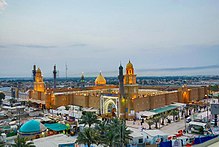
When Muhammad died in 632 CE, Ali and Muhammad's closest relatives made the funeral arrangements. While they were preparing his body, Abu Bakr, Umar, and Abu Ubayda ibn al-Jarrah met with the leaders of Medina and elected Abū Bakr as the first caliph. After reasserting Muslim control over the dissident tribes of Arabia, Abu Bakr sent armies to fight against the Byzantine Empire and Sasanian Empire, initiating a wave of conquests which were continued by his successor Umar (r. 634–644).[14] The latter's successor Uthman (r. 644–656) was a son-in-law of Muhammad and a brother-in-law of Ali. Uthman's unpopular policies elicited discontent and he was eventually assassinated in 656, after which the rebels and townspeople of Medina invited Ali to become the fourth caliph as the last source,[19] and he established his capital in Kufa, a city in present-day Iraq.[3]
Ali's rule over the early Islamic empire, between 656 CE to 661 CE, was often contested.[14] Tensions eventually led to the First Fitna, the first major civil war between Muslims within the empire, which began as a series of revolts fought against Ali. While the rebels had previously affirmed the legitimacy of Ali's khilafāʾ (caliphate), they later turned against Ali and fought him.[19] Tensions escalated into the Battle of the Camel in 656, where Ali's forces emerged victorious against A'isha, Talha ibn Ubayd Allah, and al-Zubayr ibn al-Awwam. However, the Battle of Siffin in 657 turned the tide against Ali, who lost due to arbitration issues with Mu'awiya, the governor of Syria.[14] Ali withdrew to Kufa, overcoming the Kharijis, a faction that had transformed from supporters to bitter rivals, at Nahrawan in 658. In 661, Ali was assassinated by a Kharijite assassin in Kufa while in the act of prostration during prayer (sujud). Subsequently, Mu'awiya asserted his claim to the caliphate.[62][20]
Hasan, Husayn, and Karbala

Upon the death of Ali, his elder son Hasan became leader of the Kufan Muslims. After a series of skirmishes between the Kufa Muslims and the army of Mu'awyiya, Ḥasan ibn Ali agreed to cede the caliphate to Mu'awiya and maintain peace among Muslims upon certain conditions: The enforced public cursing of Ali, e.g. during prayers, should be abandoned; Mu'awiya should not use tax money for his own private needs; There should be peace, and followers of Ḥasan should be given security and their rights; Mu'awiya will never adopt the title of Amir al-Mu'minin ("commander of the believers"); Mu'awiya will not nominate any successor.[63][64] Ḥasan then retired to Medina, where in 670 CE he was poisoned by his wife Ja'da bint al-Ash'ath, after being secretly contacted by Mu'awiya who wished to pass the caliphate to his own son Yazid and saw Ḥasan as an obstacle.[65]

Ḥusayn ibn Ali, Ali's younger son and brother to Hasan, initially resisted calls to lead the Muslims against Mu'awiya and reclaim the caliphate. In 680 CE, Mu'awiya died and passed the caliphate to his son Yazid, and breaking the treaty with Hasan ibn Ali. Yazid asked Husayn to swear allegiance (bay'ah) to him. Ali's faction, having expected the caliphate to return to Ali's line upon Mu'awiya's death, saw this as a betrayal of the peace treaty and so Ḥusayn rejected this request for allegiance. There was a groundswell of support in Kufa for Ḥusayn to return there and take his position as caliph and Imam, so Husayn collected his family and followers in Medina and set off for Kufa.[14]
En route to Kufa, Husayn was blocked by an army of Yazid's men, which included people from Kufa, near Karbala (modern Iraq); rather than surrendering, Husayn and his followers chose to fight. In the Battle of Karbala, Ḥusayn and approximately 72 of his family members and followers were killed, and Husayn's head was delivered to Yazid in Damascus. The Shi'a community regard Husayn ibn Ali as a martyr (shahid), and count him as an Imam from the Ahl al-Bayt. The Battle of Karbala and martyrdom of Husayn ibn Ali is often cited as the definitive separation between the Shia and Sunnī sects of Islam. Ḥusayn is the last Imam following Ali mutually recognized by all branches of Shia Islam.[66] The martyrdom of Husayn and his followers is commemorated on the Day of Ashura, occurring on the tenth day of Muharram, the first month of the Islamic calendar.[14]
Imamate of the Ahl al-Bayt


Later, most denominations of Shia Islam, including Twelvers and Ismāʿīlīs, became Imamis.[9][68][69] Imami Shīʿītes believe that Imams are the spiritual and political successors to Muhammad.[70] Imams are human individuals who not only rule over the Muslim community with justice, but also are able to keep and interpret the divine law and its esoteric meaning. The words and deeds of Muhammad and the Imams are a guide and model for the community to follow; as a result, they must be free from error and sin, and must be chosen by divine decree (nass) through Muhammad.[71][72] According to this view peculiar to Shia Islam, there is always an Imam of the Age, who is the divinely appointed authority on all matters of faith and law in the Muslim community. Ali was the first Imam of this line, the rightful successor to Muhammad, followed by male descendants of Muhammad through his daughter Fatimah.[70][73]
This difference between following either the Ahl al-Bayt (Muhammad's family and descendants) or pledging allegiance to Abū Bakr has shaped the Shia–Sunnī divide on the interpretation of some Quranic verses, hadith literature (accounts of the sayings and living habits attributed to the Islamic prophet Muhammad during his lifetime), and other areas of Islamic belief throughout the history of Islam. For instance, the hadith collections venerated by Shia Muslims are centered on narrations by members of the Ahl al-Bayt and their supporters, while some hadith transmitted by narrators not belonging to or supporting the Ahl al-Bayt are not included. Those of Abu Hurairah, for example, Ibn Asakir in his Taʿrikh Kabir, and Muttaqi in his Kanzuʿl-Umma report that ʿUmar ibn al-Khaṭṭāb lashed him, rebuked him, and forbade him to narrate ḥadīth from Muhammad. ʿUmar is reported to have said: "Because you narrate hadith in large numbers from the Holy Prophet, you are fit only for attributing lies to him. (That is, one expects a wicked man like you to utter only lies about the Holy Prophet.) So you must stop narrating hadith from the Prophet; otherwise, I will send you to the land of Dus." (An Arab clan in Yemen, to which Abu Hurairah belonged). According to Sunnī Muslims, Ali was the fourth successor to Abū Bakr, while Shia Muslims maintain that Ali was the first divinely sanctioned "Imam", or successor of Muhammad. The seminal event in Shia history is the martyrdom at the Battle of Karbala of Ali's son, Husayn ibn Ali, and 71 of his followers in 680 CE, who led a non-allegiance movement against the defiant caliph.

It is believed in Twelver and Ismāʿīlī branches of Shia Islam that divine wisdom (ʿaql) was the source of the souls of the prophets and Imams, which bestowed upon them esoteric knowledge (ḥikmah), and that their sufferings were a means of divine grace to their devotees.[74][75] Although the Imam was not the recipient of a divine revelation (waḥy), he had a close relationship with God, through which God guides him, and the Imam, in turn, guides the people. Imamate, or belief in the divine guide, is a fundamental belief in the Twelver and Ismāʿīlī branches of Shia Islam, and is based on the concept that God would not leave humanity without access to divine guidance.[76]
Imam Mahdi, last Imam of the Shia
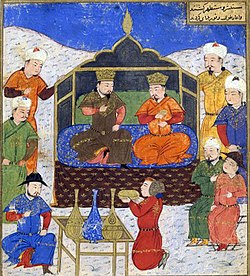
In Shia Islam, Imam Mahdi is regarded as the prophesied eschatological redeemer of Islam who will rule for seven, nine, or nineteen years (according to differing interpretations) before the Day of Judgment and will rid the world of evil. According to Islamic tradition, the Mahdi's tenure will coincide with the Second Coming of Jesus (ʿĪsā), who is to assist the Mahdi against the Masih ad-Dajjal (literally, the "false Messiah" or Antichrist). Jesus, who is considered the Masih ("Messiah") in Islam, will descend at the point of a white arcade east of Damascus, dressed in yellow robes with his head anointed. He will then join the Mahdi in his war against the Dajjal, where it is believed the Mahdi will slay the Dajjal and unite humankind.
Dynasties
In the century following the Battle of Karbala (680 CE), as various Shia-affiliated groups diffused in the emerging Islamic world, several nations arose based on a Shia leadership or population.
- Idrisids (788–985 CE): a Zaydi dynasty in what is modern Morocco.
- Qarmatians (899–1077 CE): an Ismaili Iranian dynasty. Their headquarters were in Eastern Arabia and Bahrain. It was founded by Abu Sa'id al-Jannabi.
- Buyids (934–1055 CE): a Twelver Iranian dynasty. at its peak consisted of large portions of modern-day Iran and Iraq.
- Uqaylids (990–1096 CE): a Shia Arab dynasty with several lines that ruled in various parts of al-Jazira, northern Syria and Iraq.
- Ilkhanate (1256–1335): a Persianate Mongol khanate established in Persia in the 13th century, considered a part of the Mongol Empire. The Ilkhanate was based, originally, on Genghis Khan's campaigns in the Khwarezmid Empire in 1219–1224, and founded by Genghis's grandson, Hulagu, in territories in Western and Central Asia which comprise most of Iran, Iraq, Afghanistan, Turkmenistan, Armenia, Azerbaijan, Georgia, Turkey, and Pakistan. The Ilkhanate initially embraced many religions, but was particularly sympathetic to Buddhism and Christianity. Later Ilkhanate rulers, beginning with Ghazan in 1295, chose Islam as the state religion; his brother Öljaitü promoted Shia Islam.[77]
- Bahmanids (1347–1527): a Shia Muslim state of the Deccan Plateau in Southern India, and one of the great medieval Indian kingdoms.[78] Bahmanid Sultanate was the first independent Islamic kingdom in Southern India.[79]

Fatimid Caliphate

- Fatimids (909–1171 CE): Controlled much of North Africa, the Levant, parts of Arabia, and the holy cities of Mecca and Medina. The group takes its name from Fāṭimah, Muhammad's daughter, from whom they claim descent.
- In 909 CE, the Shia military leader Abu Abdallah al-Shiʻi overthrew the Sunni rulers in North Africa, an event which led to the foundation of the Fatimid Caliphate.[80]
- Al-Qaid Jawhar ibn Abdallah (Arabic: جوهر; fl. 966–d. 992) was a Shia Fatimid general. Under the command of Caliph al-Muʻizz, he led the conquest of North Africa and then of Egypt,[81] founded the city of Cairo[82] and the al-Azhar Mosque. A Greek slave by origin, he was freed by al-Muʻizz.[83]
Safavid Empire

A major turning point in the history of Shia Islam was the dominion of the Safavid dynasty (1501–1736) in Persia. This caused a number of changes in the Muslim world:
- The ending of the relative mutual tolerance between Sunnīs and Shias that existed from the time of the Mongol conquests onwards and the resurgence of antagonism between the two groups.
- Initial dependence of Shīʿīte clerics on the state followed by the emergence of an independent body of ulama capable of taking a political stand different from official policies.[86]
- The growth in importance of Persian centers of Islamic education and religious learning, which resulted in the change of Twelver Shīʿīsm from being a predominantly Arab phenomenon to become predominantly Persian.[87]
- The growth of the Akhbari school of thought, which taught that only the Quran, ḥadīth literature, and sunnah (accounts of the sayings and living habits attributed to the Islamic prophet Muhammad during his lifetime) are to be bases for verdicts, rejecting the use of reasoning.
With the fall of the Safavids, the state in Persia—including the state system of courts with government-appointed judges (qāḍī)—became much weaker. This gave the sharīʿa courts of mujtahid an opportunity to fill the legal vacuum and enabled the ulama to assert their judicial authority. The Usuli school of thought also increased in strength at this time.[88]
-
The declaration of Twelver Shīʿīsm as the state religion of Safavid Persia
-
Monument commemorating the Battle of Chaldiran, where more than 7,000 Muslims of the Shia and Sunnī sects killed each other
Demographics
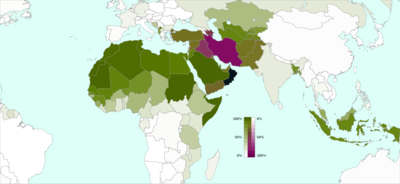
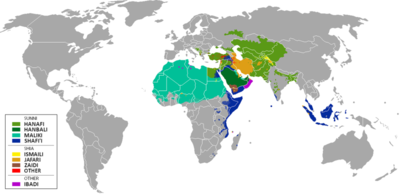
Shia Islam is the second largest branch of Islam.[90] It is estimated that either 10–20%[91] or 10–13%[92][93][94] of the global Muslim population are Shias. They may number up to 200 million as of 2009.[93] As of 1985, Shia Muslims are estimated to be 21% of the Muslim population in South Asia, although the total number is difficult to estimate.[95]
Shia Muslims form a distinct majority of the population in two countries of the Muslim world: Azerbaijan and Iran.[96][97] Shia Muslims constitute 36.3% of the entire population (and 38.6% of the Muslim population) of the Middle East.[98]
Estimates have placed the proportion of Shia Muslims in Lebanon between 27% and 45% of the population,[96][99] 30–35% of the citizen population in Kuwait (no figures exist for the non-citizen population),[100][101] over 20% in Turkey,[93][102] 5–20% of the population in Pakistan,[103][93] and 10–19% of Afghanistan's population.[104][105]
Saudi Arabia hosts a number of distinct Shia communities, including the Twelver Baharna in the Eastern Province and Nakhawila of Medina, and the Ismāʿīlī Sulaymani and Zaydī Shias of Najran. Estimations put the number of Shīʿīte citizens at roughly 15% of the local population.[106] Approximately 40% of the population of Yemen are Shia Muslims.[107][108]
Significant Shia communities also exist in the coastal regions of West Sumatra and Aceh in Indonesia (see Tabuik).[109] The Shia presence is negligible elsewhere in Southeast Asia, where Muslims are predominantly Shāfiʿī Sunnīs.
A significant Shia minority is present in Nigeria, made up of modern-era converts to a Shīʿīte movement centered around Kano and Sokoto states.[93][94][110] Several African countries like Kenya,[111] South Africa,[112] Somalia,[113] etc. hold small minority populations of various Shia subsects, primarily descendants of immigrants from South Asia during the colonial period, such as the Khoja.[114]
Significant populations worldwide
Figures indicated in the first three columns below are based on the October 2009 demographic study by the Pew Research Center report, Mapping the Global Muslim Population.[93][94]

